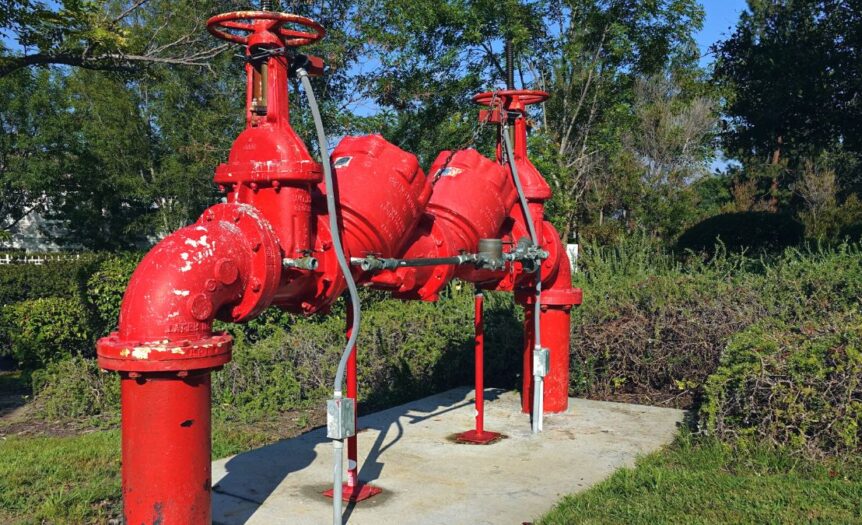Backflow preventers are crucial devices that help keep communities safe from water supply contamination. Thanks to their importance, these devices are also found in many different applications, including fire suppression. Learn more about the role of backflow prevention in fire suppression systems.
The Basics of Backflow Prevention
Many devices and systems that require a constant water supply are hooked up to public service lines. These systems include plumbing, irrigation, and, of course, fire suppression. Backflow occurs when contaminated water flows backward, re-entering the potable water supply with pollutants, chemicals, and other contaminants.
These backflow instances are often caused by main line interruptions, cross-connection ruptures, or other disruptions that drop water pressure. Backflow prevention devices are attached to these cross-connection areas to provide superior protection against reverse water flow. When backflow occurs, prevention systems activate and block the contaminated water from re-entering the public supply.
Backflow Prevention In Fire Suppression Systems
As mentioned before, fire suppression systems are often hooked up to municipal water lines. And while it’s highly unlikely that your fire sprinklers will be responsible for causing backflow issues, disruptions to the main water line itself can trigger cross-contamination. Since many fire suppression systems distribute water mixtures that contain chemicals and other pollutants, preventing backflow is extremely important for protecting the surrounding communities.
Additionally, water within the pumps and piping is often quite dirty, making it even more harmful for human consumption. Ultimately, many local governments enforce backflow prevention regulations for businesses and residents; these regulations require proper preventer devices on all connections to municipal lines.
Applicable Backflow Preventer Assemblies
There are a few different backflow preventers available for fire suppression systems, including double-check valves and reduced-pressure backflow preventers. As their name suggests, double-check valve backflow assemblies (DCVAs) feature two check valves and two shutoff valves. DCVAs are incredibly effective at preventing backflow well before issues arise.
However, they do require an additional pressure regulator to ensure proper backflow preventer functionality. Due to smaller spaces, most suppression systems opt for a reduced-pressure backflow device. This preventer has a built-in sensor and pressure regulator valve, saving you time and money by eliminating the need for additional equipment. It’s worth consulting with a professional plumbing business to determine the best backflow assemblies for your application.
While the evolution of fire suppression systems has seen some beneficial changes in recent years, these fire suppression systems still rely on backflow prevention to ensure safety for everyone in the community. Make sure your fire sprinklers are properly protected by installing the proper prevention device.










 Deering Estate
Deering Estate
 Massage Envy South Miami
Massage Envy South Miami
 Calla Blow Dry
Calla Blow Dry
 My Derma Clinic
My Derma Clinic
 Sushi Maki
Sushi Maki
 Sports Grill
Sports Grill
 The Healthy Kitchen
The Healthy Kitchen
 Golden Rule Seafood
Golden Rule Seafood
 Malanga Cuban Café
Malanga Cuban Café

 Kathleen Ballard
Kathleen Ballard
 Panter, Panter & Sampedro
Panter, Panter & Sampedro
 Vintage Liquors
Vintage Liquors
 The Dog from Ipanema
The Dog from Ipanema
 Rubinstein Family Chiropractic
Rubinstein Family Chiropractic
 Your Pet’s Best
Your Pet’s Best
 Indigo Republic
Indigo Republic




 ATR Luxury Homes
ATR Luxury Homes


 2112 Design Studio
2112 Design Studio
 Hamilton Fox & Company
Hamilton Fox & Company
 Creative Design Services
Creative Design Services
 Best Pest Professionals
Best Pest Professionals
 HD Tree Services
HD Tree Services
 Trinity Air Conditioning Company
Trinity Air Conditioning Company
 Cisca Construction & Development
Cisca Construction & Development
 Mosquito Joe
Mosquito Joe
 Cutler Bay Solar Solutions
Cutler Bay Solar Solutions


 Miami Royal Ballet & Dance
Miami Royal Ballet & Dance
 Christopher Columbus
Christopher Columbus
 Pineview Preschools
Pineview Preschools
 Westminster
Westminster
 Carrollton
Carrollton
 Lil’ Jungle
Lil’ Jungle
 Frost Science Museum
Frost Science Museum
 Palmer Trinity School
Palmer Trinity School
 South Florida Music
South Florida Music
 Pinecrest Orthodontics
Pinecrest Orthodontics
 Dr. Bob Pediatric Dentist
Dr. Bob Pediatric Dentist
 d.pediatrics
d.pediatrics
 South Miami Women’s Health
South Miami Women’s Health

 The Spot Barbershop
The Spot Barbershop
 My Derma Clinic
My Derma Clinic




 Miami Dance Project
Miami Dance Project

 Rubinstein Family Chiropractic
Rubinstein Family Chiropractic
 Indigo Republic
Indigo Republic

 Safes Universe
Safes Universe
 Vintage Liquors
Vintage Liquors
 Evenings Delight
Evenings Delight





 Atchana’s Homegrown Thai
Atchana’s Homegrown Thai
 Baptist Health South Florida
Baptist Health South Florida

 Laser Eye Center of Miami
Laser Eye Center of Miami
 Visiting Angels
Visiting Angels
 OpusCare of South Florida
OpusCare of South Florida

 Your Pet’s Best
Your Pet’s Best





 HD Tree Services
HD Tree Services
 Hamilton Fox & Company
Hamilton Fox & Company


 Creative Design Services
Creative Design Services